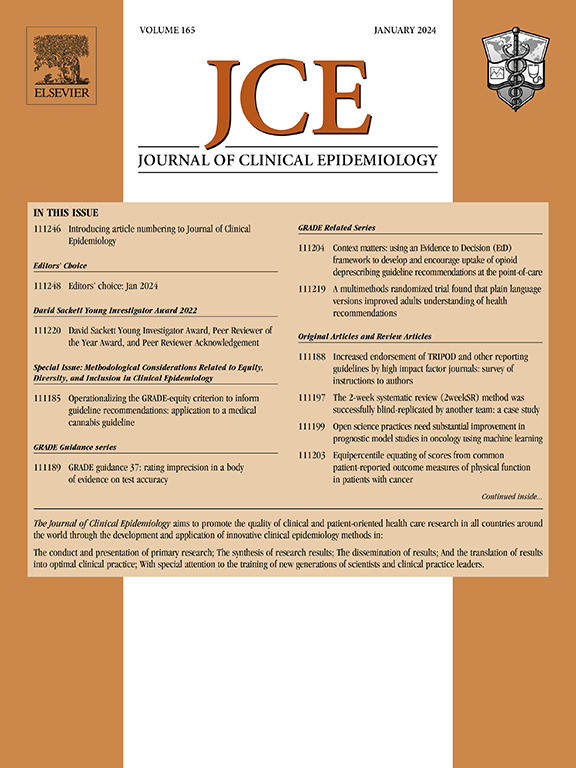Review of methods to deal with the misalignment of times of eligibility, start of follow-up, and treatment assignment in studies explicitly aimed at emulating target trials
IF 5.2
2区 医学
Q1 HEALTH CARE SCIENCES & SERVICES
引用次数: 0
Abstract
Objectives
Real world evidence based on observational data from cohorts, registries, and health-care databases are increasingly used to assess the effectiveness of therapeutic interventions, often using the target trial emulation framework. One challenge when analyzing observational data are risks of biases due to misalignment of times of eligibility, start of follow-up, and treatment assignment. We aimed to describe the methods used to generate alignment or to account for misalignment in studies explicitly aimed at emulating target trials, and to estimate the proportion of studies for which a low-cost change would limit the risk of biases associated with misalignment of the times.
Study Design and Setting
We analyzed 199 studies explicitly aiming at emulating a target trial identified in a previous systematic review from Hansford et al. Two reviewers extracted the times of eligibility, start of follow-up, and treatment assignment and the methods used by authors to generate alignment or to account for misalignment of time points.
Results
Out of the 199 studies, 181 (91%) reported the times of eligibility, start of follow-up, and treatment assignment. All time points were aligned for 93/181 (51%), with 73 using no specific method, 18 emulating a sequence of target trials, and 2 using other methods to generate alignment. In contrast, 88/181 (49%) studies had misalignment of time points, of which 29 used a method to correct for misalignment during analysis (24 studies used a cloning, censoring, and weighting approach; 4 randomly allocated patients with early events; and 1 randomly allocated all participants to the study groups with subsequent censoring when they deviated from the allocated intervention). Out of 59/88 (67%) studies that did not use any method to address nonalignment, 46/59 (78%) could have applied low-cost changes to account for misalignment.
Conclusion
Approximately, half of the studies explicitly aiming to emulate a target trial had alignment of times of eligibility, start of follow-up, and treatment assignment, either by design or using a method generating alignment. Among studies with misalignment, about 67% did not account for it in the analysis among which 78% could have applied low-cost changes to reduce bias.
Plain Language Summary
Researchers increasingly use real-world evidence from sources like routinely collected or claims data to assess the efficacy and safety of therapeutic interventions (medications, surgery, physiotherapy, etc). To prevent design errors when analyzing these data, researchers follow a framework called “target trial emulation”. A crucial aspect of this framework is to ensure that three key time points of the study are aligned during analysis: the times at which 1) participants in the database are assessed for eligibility in the study (ie, when do we choose to include them or not in the analysis), 2) their follow-up begin, and 3) they are assigned to a treatment group. If these time points are misaligned, the study results can be biased. Here, we reviewed 199 published studies that explicitly aimed to emulate a target trial identified in a previous systematic review by Hansford et al. We found that about half of them had alignment between of times of eligibility, treatment assignment, and follow-up. In the other half, there was misalignment but one-third used specific methods to correct for this problem. Many studies that aim to emulate a trial may have issues in alignment of key time points, which can compromise the validity of their findings. Most of these issues could be corrected with straightforward adjustments.
回顾在明确旨在模拟目标试验的研究中,处理入组时间、随访开始时间和治疗分配不一致的方法。
目的:基于来自队列、登记和卫生保健数据库的观察性数据的真实世界证据越来越多地用于评估治疗干预措施的有效性。在分析观察性数据时面临的一个挑战是由于资格时间、随访开始时间和治疗分配不一致而存在偏倚风险。我们的目的是描述在这些研究中用于产生对齐或解释不对齐的方法;并估计低成本的改变会限制与时代偏差相关的偏差风险的研究比例。研究设计和设置:我们分析了199项研究,明确旨在模拟Hansford等人先前系统评价中确定的目标试验。两位审稿人提取了符合条件的时间、随访开始时间、治疗分配时间以及作者用于产生对齐或解释时间点不对齐的方法。结果:在199项研究中,181项(91%)报告了资格、随访开始和治疗分配的时间。所有时间点对齐93/181(51%),其中73例未使用特定方法,18例模拟目标试验序列,2例使用其他方法生成对齐。相比之下,181项研究中有88项(49%)存在时间点偏差,其中29项研究在分析过程中采用了纠正偏差的方法(24项研究采用克隆、审查和加权方法,4项研究随机分配早期事件患者,1项研究将所有参与者随机分配到实验组,当他们偏离随机分配的干预措施时,随后进行审查)。在59/88(67%)未使用任何方法解决不对齐的研究中,46/59(78%)可以应用低成本变化来解释不对齐。结论:通过设计或使用生成校准的方法,大约有一半明确旨在模拟目标试验的研究对合格时间、随访开始和治疗分配进行了校准。在有偏差的研究中,约67%的研究没有在分析中考虑到这一点,而78%的研究可以采用低成本的改变来减少偏倚。
本文章由计算机程序翻译,如有差异,请以英文原文为准。
求助全文
约1分钟内获得全文
求助全文
来源期刊

Journal of Clinical Epidemiology
医学-公共卫生、环境卫生与职业卫生
CiteScore
12.00
自引率
6.90%
发文量
320
审稿时长
44 days
期刊介绍:
The Journal of Clinical Epidemiology strives to enhance the quality of clinical and patient-oriented healthcare research by advancing and applying innovative methods in conducting, presenting, synthesizing, disseminating, and translating research results into optimal clinical practice. Special emphasis is placed on training new generations of scientists and clinical practice leaders.
 求助内容:
求助内容: 应助结果提醒方式:
应助结果提醒方式:


